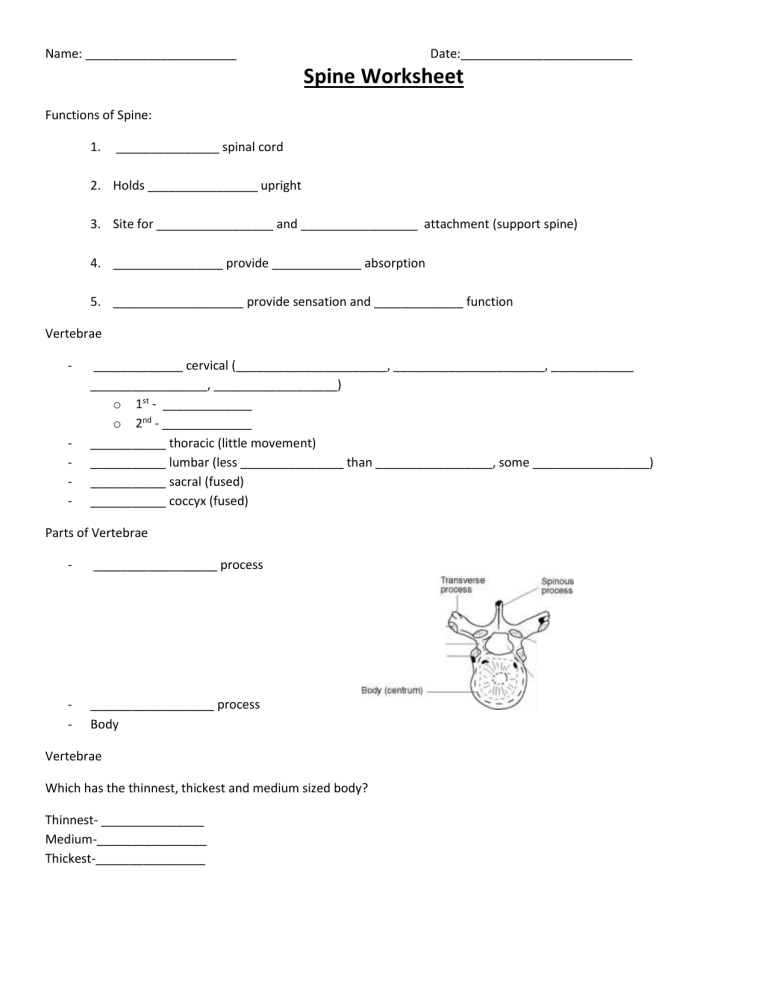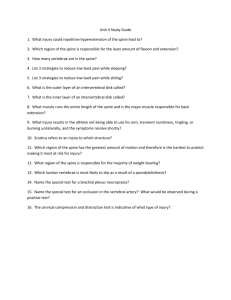
Name: ______________________ Date:_________________________ Spine Worksheet Functions of Spine: 1. _______________ spinal cord 2. Holds ________________ upright 3. Site for _________________ and _________________ attachment (support spine) 4. ________________ provide _____________ absorption 5. ___________________ provide sensation and _____________ function Vertebrae - - _____________ cervical (______________________, ______________________, ____________ _________________, __________________) o 1st - _____________ o 2nd - _____________ ___________ thoracic (little movement) ___________ lumbar (less _______________ than _________________, some _________________) ___________ sacral (fused) ___________ coccyx (fused) Parts of Vertebrae - __________________ process - __________________ process Body Vertebrae Which has the thinnest, thickest and medium sized body? Thinnest- _______________ Medium-________________ Thickest-________________ [Type text] Posture - ________________ Spine o Normal alignment ________________ Curve o Excessive -- ___________ _______________ Curve o Excessive -- ___________ Discs - Fibrocartilaginous _______________ absorbers Resist Compression Keep __________________ separated Allows movement and flexibility Provides space for _______________ to exit _______________ blood supply - Nucleus Pulposus o Jelly-like core Annulous Fibrosus o Cartilaginous outer rings [Type text] Muscles - Provide ______________________ and ____________________ Deep – Erector Spinae o Attach to ______________________, ____________, and __________________ o 3 Groups ________________________ __________________________ __________________________ - Abdominal muscles play big role in stabilizing back Trunk _______________, lateral _________________, _____________________ o o o o Trapezius - ______________________ extension Sternocleidomastoid- _____________________ ___________, rotation Scalenes- _______________________ Multifidus - ____________________ of the spine - [Type text] Nerves - Each vertebrae has a nerve that exits either below or above it 31 pairs of spinal nerves o 8 cervical o 12 thoracic o 5 lumbar o 5 sacral o 1 coccygeal Spinal Cord - Part of _______________ along with brain Contained within vertebral canal Extends from cranium to 1st-2nd vertebrae _______________ roots and _____________ nerves for a “__________-like tail” called ______________ ____________ 2 plexuses o ____________________, _____________________________ Dermatomes - Area of body that has nerve __________________ for each nerve ________________ Myotomes - Area of body that has ____________________ function Posture - _______________ o Slight curve at thoracic and lumbar areas, ears in line with shoulders Problems o ______________________________ - ears in front of line with shoulder o ____________________ -- excessive curve of thoracic spine o ____________________ -- excessive curve of lumbar spine o ___________________-- Lateral curve of spine Common Injuries Identify the MOI (Mechanism of Injury), Structures Involved, Signs/Symptoms, Immediate Treatment 1. Lumbar Sprain a. MOI b. Structures Involved/Signs and Symptoms c. Immediate Treatment [Type text] 2. Lumbar Strain a. MOI b. Structures Involved/Signs and Symptoms c. Immediate Treatment 3. Lumbar Fracture a. MOI b. Structures Involved/Signs and Symptoms c. Immediate Treatment 4. Disc Injury/Herniation a. MOI b. Structures Involved/Signs and Symptoms c. Immediate Treatment 5. Cervical Sprain a. MOI b. Structures Involved/Signs and Symptoms c. Immediate Treatment 6. Cervical Strain a. MOI b. Structures Involved/Signs and Symptoms c. Immediate Treatment 7. Cervical Fractures/Dislocations a. MOI b. Structures Involved/Signs and Symptoms c. Immediate Treatment 8. Spinal Cord Injury a. Decerebrate b. Decorticate c. Immediate Treatment [Type text] 9. Cervical Disc Injury a. MOI b. Structures Involved/Signs and Symptoms c. Immediate Treatment 10. Brachial Plexus Injury a. MOI b. Structures Involved/Signs and Symptoms c. Immediate Treatment Spine Boarding Procedure - Observation: ( On the way to athlete) o If athlete is unconscious ALWAYS assume spinal injury. - Arrival and Primary Survey o Stabilize head and neck - Check for level of consciousness o If unconscious call 911 o If conscious and able to communicate signs/symptoms of neck injury call 911 - If unconscious: Look, listen and feel o If not breathing either you (if alone) or another member of medical use pocket mask or remove face mask and begin rescue breathing/CPR o If breathing continue to maintain stabilization and assess athlete - If athlete is supine with neck turned to side, maintain stabilization and rotate head in align with neck. If athlete is able to communicate, if movement increases symptoms STOP. - Reasons not to move neck: o Increased pain o Neurological symptoms o Muscle spasm o Airway compromise o If it is physically difficult to reposition the spine o Resistance is encountered o Patient expresses apprehension Lift and Slide Technique - The ATC in charge (A0) supports and stabilizes the head and cervical spine, maintaining this position throughout the procedure. - This rescuer is also responsible for coordinating the entire procedure through direct, verbal commands (the “Captain” or “head”) - A1and A2, kneel by victim’s shoulders (each on opposite sides) with one hand on the posterolateral aspect of the shoulder and the other hand on the flank. - A3 straddles the victim, faces A0 and places his/her hands beneath the victim’s waist - A4 straddles the victim and faces A0 and places his/her hands beneath the victim’s knees/calves. [Type text] - A5 stands behind A4 and is responsible for sliding a spine board beneath the victim. The spine board should be placed lengthwise by the victim’s feet, before the procedure begins. On command of A0, the victim should be lifted off the ground (approximately 10-12 inches) as a unit, just enough to permit A5 to slide the spine board beneath the victim On command of A0 the victim should be gently lowered onto the spine board.
